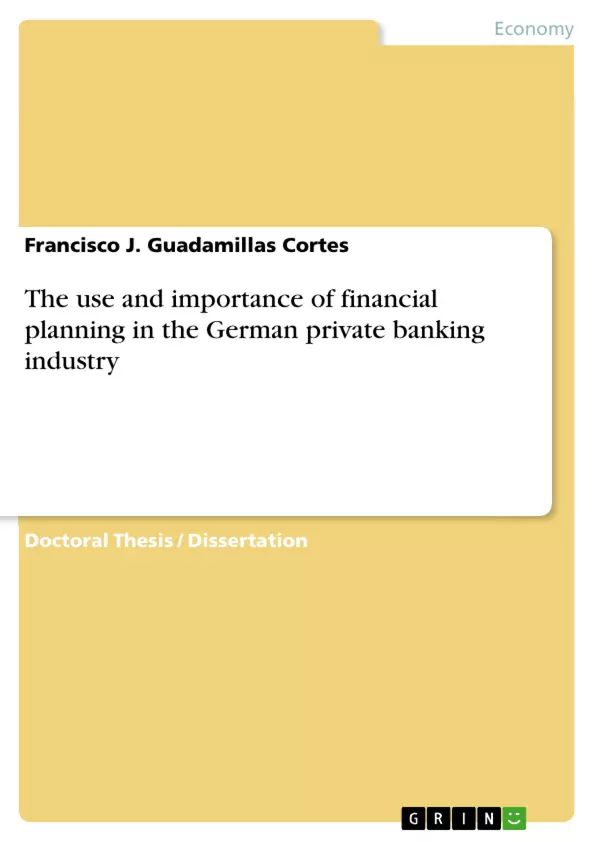“The once so powerful financial institutions of the old "German Plc.", which in times of the
economic miracle partly controlled the fortune of the large scale industry, are facing the
greatest test of its latest history."1 This quotation from the year 2002 of two economic experts
reflects the situation, which the German banking industry was in, in recent years, and still is
in respectively. Even if many financial institutions are recovering, the reasons for the poor
situation are manifold.2 Questions about the banking model of the future are raised as well as
questions about the most successful business sectors. While investment banking is particularly
profitable in times of stock market booms, mergers and IPO's, it however turned out, that the
relatively stable business with private clients, especially with the wealthy ones, turns out to be
a solid source of recurrent income. Banks like e.g. UBS, Credit Suisse or Deutsche Bank are
making high profits, whose basis is more and more the private client business. That way, the
UBS drew a record profit of CHF 14.1 billion (approx. 9 billion €) in 2005.
Inhaltsverzeichnis (Table of Contents)
- Introduction
- Presentation of the issue
- Objective and structure of the thesis
- Definition of private clients resp. the private banking market in Germany
- The different private client segments and their differentiation in general
- The retail banking
- The private banking
- The private wealth management
- The family office
- Offerings and concepts of client attention of the financial service providers
- Offered services within the private banking segment
- Offered services within the private wealth management segment
- Offered services within the family office segment
- Types and structure of the family office
- The products and services of the family office
- Particularities of families and dynasties
- Benefits of the family office-concept for providers and clients
- Disadvantages of the family office-concept for providers and clients
- Market- and potential analysis of the wealthy private clients in Germany
- Size and potential of the market
- Origin of the wealth and behaviour of the wealthy private clients
- Current requirements of the wealthy private clients
- The importance of financial planning in the private banking industry
- Initial situation and presentation of the issue
- Definitions
- Definition of the Financial Planning Association (FPA)
- Definition of the International Association for Financial Planning (IAFP)
- Definition of the Institute of Certified Financial Planners (ICFP)
- Definition according to Dr. Rolf Tilmes
- Definition of Schäfer and Unkel
- Summary of the definitions
- Historical development, origin and classification of financial planning
- The customers of financial planning
- Target groups and market potential
- The use of financial planning in the private banking segment
- Instruments, costs and benefits of financial planning
- Benefits for the customer
- Benefits for the provider
- Content and process of financial planning
- Content of financial planning
- Principles of duly financial planning
- The process of financial planning and its phases
- Realisation and problems of the financial planning in practice
- Principal possibilities of price structuring in the financial planning
- Commission versus fee
- Diverse price models at the market
- Models of banks
- Models of independent providers
- Payment willingness of clients
- The problematic nature of financial planning against fees
- The economical problems
- Information asymmetries
- The principal-agent problem
- The legal problems
- The liability in case of investment procurement and investment advice
- The consequences for financial planners
- Potential methods of resolutions
- Diminution of insecurities and information asymmetries
- Price-transparency and genuine pricing
- Cooperation with tax- and legal experts
- Summary and perspective
Zielsetzung und Themenschwerpunkte (Objectives and Key Themes)
This thesis aims to analyze the use and importance of financial planning within the German private banking industry. It seeks to define the relevant market segments, explore the current demand for financial planning services, and examine the practical challenges and potential solutions related to its implementation and pricing.
- Definition and segmentation of the German private banking market
- Analysis of the demand for financial planning services among different client segments
- Examination of the costs and benefits of financial planning for both clients and providers
- Challenges related to pricing and implementation of financial planning services
- Potential solutions to address the identified challenges
Zusammenfassung der Kapitel (Chapter Summaries)
The introduction presents the issue of financial planning in the German private banking sector, highlighting its increasing importance and the lack of academic literature on the topic. Chapter 2 defines key market segments (retail banking, private banking, wealth management, family offices) and their respective service offerings. Chapter 3 provides a market analysis of wealthy private clients in Germany, focusing on their wealth origins, current needs, and market potential. Chapter 4 defines financial planning, traces its historical development, and identifies its target groups and the benefits for both clients and providers. Chapter 5 details the content and process of financial planning. Chapter 6 explores practical challenges, particularly regarding pricing models and client payment willingness. Chapter 7 delves into the economic and legal problems associated with fee-based financial planning, such as information asymmetries and liability issues.
Schlüsselwörter (Keywords)
Financial planning, private banking, wealth management, Germany, market analysis, client segmentation, pricing models, information asymmetry, principal-agent problem, legal liability.
- Citar trabajo
- Dr. Francisco J. Guadamillas Cortes (Autor), 2006, The use and importance of financial planning in the German private banking industry, Múnich, GRIN Verlag, https://www.grin.com/document/121804



